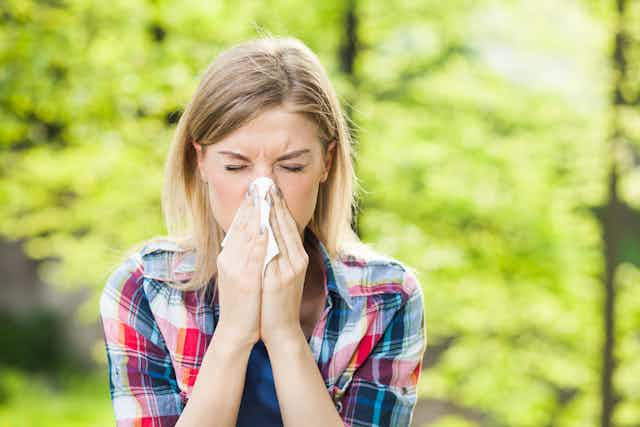Spring is a favourite time of year for many – as the earth rejuvenates, lawns become green and trees blossom. But for the 15% of Australians who get hay fever, it can be a struggle to get through the season.
At least half of all people with hay fever also have asthma. Allergens that trigger hay fever can trigger asthma attacks in people with allergic asthma.
Remind me, what are hay fever and asthma?
Hay fever isn’t caused by hay and is not accompanied by fever. Seasonal allergic rhinitis, as it’s known clinically, is caused by pollen from certain trees, grasses and weeds.
Perennial (year-long) allergic rhinitis, in contrast, is mostly caused by indoor substances, such as dust mites, chemicals in house paint, and so on.
Rhinitis refers to inflammation in the nose that leads to symptoms of hay fever: the sneezing, nasal congestion, itchy nose and runny nose. Rhinitis can be allergic, as in the case of hay fever, or non-allergic, where there is no known cause.
Asthma is a long-term inflammatory condition of the lung. People with asthma experience periods of wheezing, shortness of breath, coughing and chest tightness due to changes in the lungs.
Like rhinitis, asthma can be allergic (also known as atopic, which occurs when the person is exposed to an allergen) or non-allergic (non-atopic, when there is no allergen).
Non-allergic asthma is not related to hay fever.
How is hay fever treated?
Hay fever can make allergic asthma harder to control.
Conversely, effectively treating hay fever may reduce the chance of severe asthma attacks and make the lungs work better.
Current treatments for both hay fever and allergic asthma have a similar mode of action: limiting the body’s response to allergy triggers.
In the first instance, hay fever symptoms can be treated with over-the-counter antihistamines. Ask your pharmacist about non-sedating varieties.
If antihistamines don’t provide relief, the next treatment is corticosteroids. These are effective against all allergic conditions, including hay fever and asthma.
Corticosteroids are administered as a nasal spray for hay fever and via an inhaler for asthma. Unlike the steroids used for performance enhancement or bodybuilding, these medicines are non-addictive and long-term use doesn’t have any major side-effects.
Corticosteroid nasal sprays are available over the counter at pharmacies and can be taken before hay fever symptoms arise.
The final option for controlling hay fever is immunotherapy (also termed allergy shots or allergy vaccines). Specific immunotherapy involves the injection of increasing doses of an allergen (allergy trigger) extract. Like corticosteroids, immunotherapy is also effective against asthma.
Immunotherapy is effective, but not a quick fix. It usually takes months to show any benefits and requires a long course of routine injections, so it can be quite expensive.
Talk to your GP if you think this treatment could be useful for you. Some private health funds cover some of the costs, so talk to your health fund before starting any immunotherapy.
Sublingual immunotherapy, where the allergy-inducing substance is placed under the tongue, is emerging as a viable alternative to injections. Similar to injections, this requires routine dosing over several months.
A distinct disadvantage is its cost: it can be up to three times the cost of injections.
As specific immunotherapy bears a risk of severe allergic reactions that may be life-threatening, all immunotherapy must be performed under close clinical observation.
What if you have asthma?
If you have allergic asthma and are on a management plan with a regular inhaler, ensure you’re using it regularly and as specified by your GP as we go into hay fever season. If you don’t use a regular inhaler, talk to your GP.
If you’ve had asthma or hay fever in the past, talk to your local pharmacist about using nasal spray for hay fever prevention.
For more information on asthma and hay fever, visit:

